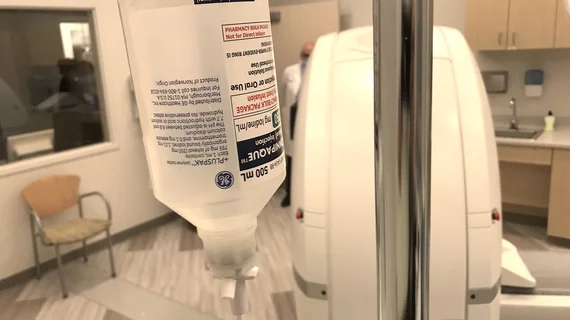GE provides update on contrast media shortage
In the wake of a nationwide iodinated contrast media shortage, many lingering questions loom as patients, providers and organizations continue to adapt while waiting for the lockdowns that triggered the supply chain issue to ease in Shanghai, China.
In an exclusive statement to Health Imaging, representatives of GE provided an update on the situation:
“Our priority is delivering for our customers and their patients, and we are working around the clock to expand capacity of our iodinated contrast media products. After having to close our Shanghai manufacturing facility for several weeks due to local COVID policies, we have been able to reopen and are utilizing our other global plants wherever we can. We are working to return to full capacity as soon as local authorities allow.” said a GE Healthcare spokesperson.
The other global plant referred to in the statement is GE’s manufacturing plant in Cork, Ireland, where production capacity has been expanded to compensate for the reduction in Omnipaque (iohexol).
Initially, it was expected that there would be a reduction of up to 80% in supply for 6 to 8 weeks. The COVID lockdowns at the Shanghai plant began on March 31 amid a new wave of infections there. Although the plant has since resumed operations, they are not yet at 100% capacity. GE shared that the plant is currently at 50% capacity and it is working with local authorities in Shanghai around the clock to try and increase the number of operators at the site in controlled groups over the next week.
Additionally, GE has also adjusted its logistic routes to speed up contrast deliveries. Shipments from both Cork and Shanghai have been switched from sea to air to deliver supplies more quickly.
GE indicated that their mitigation strategies, as well as those implemented at organizations across the country, have helped to improve the situation — a situation that is expected to continue to improve as the Shanghai plant increases worker capacity.
GE says hospitals are OK to find other sources of contrast during the shortage
Other U.S. imaging contrast media vendors might have additional contrast
GE said there are other contrast agent suppliers on the U.S. market."All of our customers, irrespective of contract, are able to source supply from alternative vendors if available," GE explained to Health Imaging.
The supply chain support vendor Vizient told its member hospitals the shortage issue is driven by GE's Iohexol (Omnipaque) and iodixanol (Visipaque), accounting for more than 50% of the contrast used on the U.S. market. Bracco Diagnostics is the second largest contrast vendor in the U.S., but Vizient said as of May 1 that vendor was not accepting new clients. Other manufactures include Bayer and Guerbet, which Vizient said account for about 5% of the market share combined.
Omnipaque is a low-osmolality contrast media (LOCM) used for computed tomography (CT) scans and X-rays for oral and body cavity, intravascular, intra-arterial and intrathecal imaging. Vizient said other LOCM iodinated contrast media include GE's iodixanol (Visipaque) which is also on shortage, Bracco's iopamidol (Isovue), Bayer's Iopromide (Ultravist) and Guerbet's ioversol (Optiray).
Health Imaging will provide additional updates on the contrast media shortage as they become available.
Related Contrast Media News:
Be prepared: IV contrast media shortage could last up to 8 weeks
Preserving contrast media supplies: 7 ACR recommendations
FDA issues safety warning for iodinated contrast media use in children
Preserving contrast media supplies: 7 ACR recommendations
VIDEO: Gadolinium being substituted for iodine contrast in some procedures due to shortage — Interview with Alan H. Matsumoto, MD
GE provides update on contrast media shortage
VIDEO: How the iodine contrast shortage is impacting interventional cath labs — Interview with Kirk Garratt, MD
VIDEO: Imaging contrast shortage is delaying procedures and causing rationing — Interview with Alan H. Matsumoto, MD
Frontline perspectives on the CT contrast shortage: 5 notable quotes
Gadolinium can be used as substitute for iodine contrast in some interventional imaging procedures

